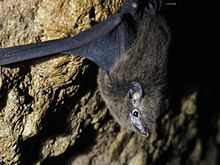Emballonuroidea
| Sac-winged bats | |
|---|---|
 |
|
| Sac-winged bat | |
| Scientific classification | |
| Kingdom: | Animalia |
| Phylum: | Chordata |
| Class: | Mammalia |
| Order: | Chiroptera |
| Suborder: | Microchiroptera |
| Superfamily: | Emballonuroidea |
| Family: |
Emballonuridae Gervais in de Castelnau, 1855 |
| Genera | |
|
See Text |
|
See Text
The 51 species of sac-winged or sheath-tailed bats constitute the family Emballonuridae, and can be found in tropical and subtropical regions all over the world. Emballonurids include some of the smallest of all bats, and range from 3.5 to 10 cm in body length. They are generally brown or grey, although the ghost bats (genus Diclidurus) are white.
They have short tails, which project through the tail membrane, so that the latter forms a sheath. As their name indicates, most species also possess sac-shaped glands in their wings, which are open to the air and may release pheromones to attract mates. Other species have throat glands which produce strong-smelling secretions. They have the dental formula
These bats prefer to roost in areas generally lighter than other species of bats. Their dwellings can often be found in hollow trees and entryways to caves or other structures. Some, such as the tomb bats, live in large roosts, but others are solitary. Species living away from the tropics may become torpid, or even hibernate in winter.
Sac-winged bats feed mainly on insects, and occasionally on fruit. Most of these bats, such as ghost bats, catch their meals while flying; the proboscis bat, on the other hand, catches its prey above water surfaces.
Family Emballonuridae
...
Wikipedia
